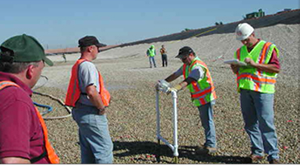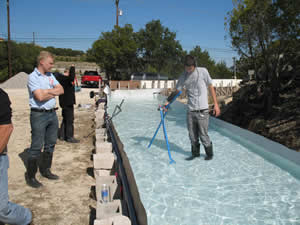 We are seeing an increasing number of LIS specifications requiring 15,000,000 ft2 of experience within the previous 3 years. This is excessive and totally unnecessary; and, I suspect, only one company can comply. But, would you be getting an individual survey operator with that experience, or a company with several operators totaling that experience? LIS technology is far from rocket science and can be learned by anyone with common sense, patience, and a little understanding of electricity principles.
We are seeing an increasing number of LIS specifications requiring 15,000,000 ft2 of experience within the previous 3 years. This is excessive and totally unnecessary; and, I suspect, only one company can comply. But, would you be getting an individual survey operator with that experience, or a company with several operators totaling that experience? LIS technology is far from rocket science and can be learned by anyone with common sense, patience, and a little understanding of electricity principles.
After performing surveys throughout North America and internationally for about 22 years, I established a liaison with TRI to form T-CLIC (the TRI, I-CORP Liner Integrity Center) to teach people how to perform surveys. We hold two-day training seminars, with one day in the classroom and one day “in the field” for hands-on work in three custom-built cells: water-covered, soil-covered, and exposed liner test cells (with GCL, conductive geomembrane, and conductive geotextile substrates). We provide certificates of course completion. Then, for those who are serious about performing surveys and who buy equipment, we audit one of their production surveys to ensure they can properly apply what they have learned. To date, there has not been an audited survey that has not presented a problem that has not been resolved by the candidate surveyors!
That is, the training works. Our audits reveal that even newly trainined surveyors, armed with an understanding of how to use this equipment, have identified problems in liner installation and provided the vital, final-stage CQA necessary to ensure that the facilities in question begin operation with the best possible liner integrity.
 T-CLIC’s field audits are backed up by a 90-minute written test of 40 questions, both multiple choice (several correct and incorrect answers) and essay type. Points are scored for correct answers and are deducted for incorrect answers. Satisfactory field work and a passing of the written test result in T-CLIC certification.
T-CLIC’s field audits are backed up by a 90-minute written test of 40 questions, both multiple choice (several correct and incorrect answers) and essay type. Points are scored for correct answers and are deducted for incorrect answers. Satisfactory field work and a passing of the written test result in T-CLIC certification.
Re-certification is required every five years with a brief written test and a client satisfaction survey.
Thus, we suggest that for the surveyor himself, an appropriate specification would be “full certification by T-CLIC, the TRI/I-CORP Liner Integrity Center”. At least two communities already do this. If it is felt that field experience is important, 2.5 million ft2 in a minimum of five projects should be adequate.
Rocket science it is NOT! The four guiding boundary condition are:
- a conductive medium over the liner
- a conductive medium through the leaks
- a conductive medium under the liner
- no contact between the media above and under the liner other than through the leaks being sought
The most important part of the survey, far more important than the number of square feet surveyed, is the number of effective calibrations performed. In fact, a comprehensive calibration is far more significant and informative than whether that project was 50 ft2 or 500,000 ft2.
Those surveyors certified by T-CLIC receive the full technical support and backing of Dr Peggs’ 25 years of geoelectric and other methods of surveying for leaks in geomembrane liners.
We suggest that 15,000,000 ft2 is excessive and too restrictive, as well as being unnecessary; that 2.5 million ft2 is more reasonable; that successful calibrations are important; and that certification by T-CLIC is all that is necessary.
Ian Peggs at icorp@geosynthetic.com and Sam Allen at sallen@tri-env.com would be pleased to discuss any aspect of liner integrity and leak location surveys. See also information about the equipment used at: www.linersurvey.com.
|
Things to Remember
|
Ian Peggs is president of I-CORP International. Visit I-CORP’s website at http://www.geosynthetic.com or write to him at icorp@geosynthetic.com.











